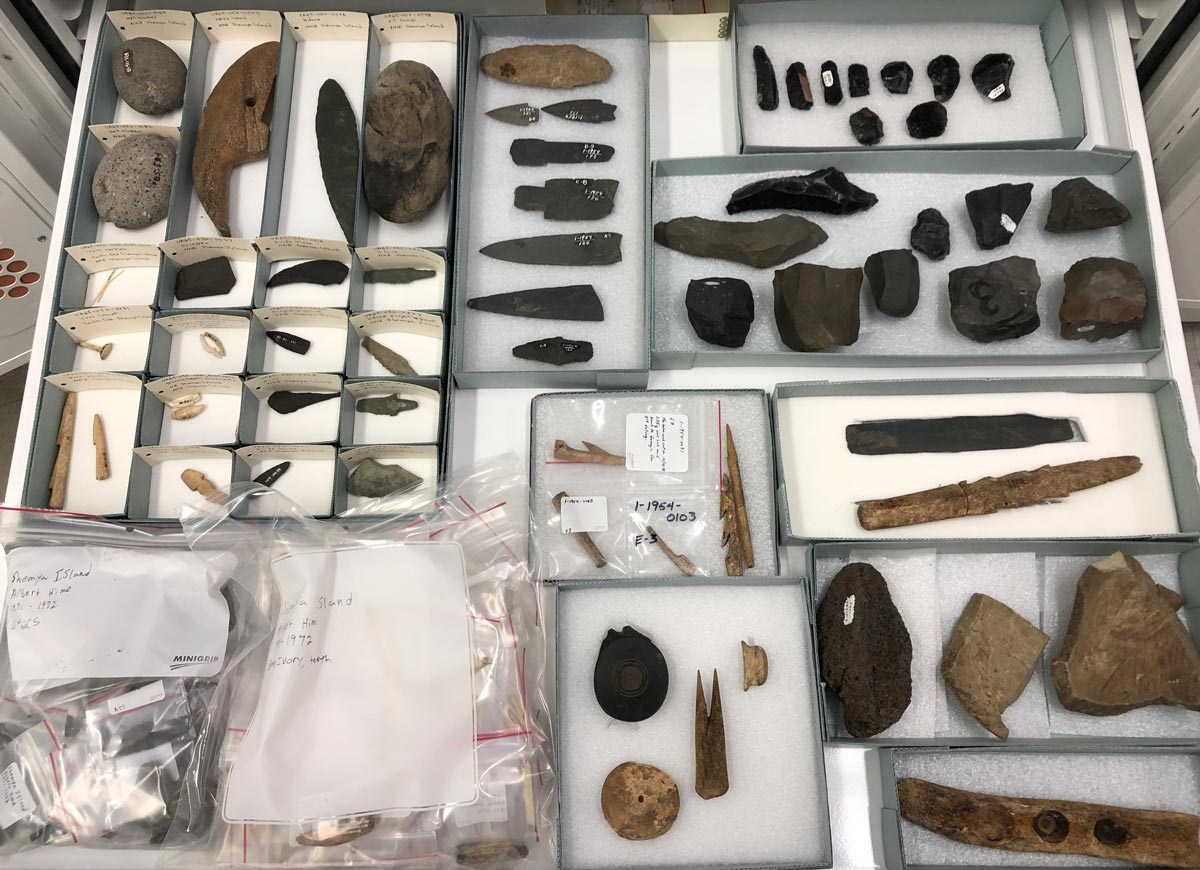November 19, 2021
by Scott Shirar and Josh Reuther

Cultural objects from archaeological sites in the Aleutian Islands and Alaska Peninsula.
In Fairbanks, at the University of Alaska Museum of the North we serve as one of the primary repositories for archaeological collections in the entire state of Alaska. This means we house and care for archaeological collections at the request of landowners from across the state. Archaeological collections include human-made cultural objects like stone projectile points, ivory harpoon heads, and ceramic oil lamps, but also include specimens from the natural world like animal bones, wood, charcoal, and soil samples. The Museum of the North began filling this role as a repository in the 1920s and we now care for over 7,000 different collections and 1,000,000 individually cataloged cultural objects and specimens. Depending on what the goals of an archaeological field project are, a wide range of collections can be produced depending on where a site is located, how old it is, and how well preserved. These collections come from every corner of the state, but also represent the entire record of humans living in Alaska going back nearly 14,500 years.

Fieldnotes written during an Archaeological Excavation in the Aleutian Islands in 1971.
In addition to storing and caring for the archaeological collections themselves, we also care for all the associated documentation and data that is created when archaeologists work at a site. This documentation includes field notes, site maps, photographs, publications, and catalogs that record exactly where an object was collected and how deeply it was buried. Archaeologists try to radiocarbon date each site they work at and this type of analysis can be done with any type of organic material collected at a site most commonly charcoal, animal bone, and wood. Archaeologists date different soil layers of a site with the idea being that each layer deeper in the ground is older than the one above it. By using these methods archaeologists can associate all the objects and specimens collected from a specific layer to a range of time. There are many archaeological sites in Alaska where people lived, sometime continuously and sometimes intermittently, over the course of hundreds and sometimes thousands of years. The Swan Point archaeological site in Interior Alaska is a great of example of this with at least six different episodes of human habitation beginning 14,500 years ago all the way up to the historic present with people living at the site most recently about 75-100 years ago.

Identified sea lion bones from archaeological sites in the Aleutian Islands.
The Aleutian Mercury Dynamics project includes a combination of new fieldwork and what is called collections-based research, which refers to working with archaeological collections that were generated through fieldwork projects carried out years and even decades in the past. Here at the Museum of the North we use a combination of our collections catalog database and the site documentation to figure out what collections we have from the Aleutian Islands, which ones are radiocarbon dated, and which ones might have preserved animal bones relevant for this study. From here we begin to access these collections and pull animal bone samples from different time periods and geographical areas that can provide us with useful information. Collections-based projects like this really highlight the importance of storing and preserving archaeological collections for as long as possible. When the Museum of the North first started storing collections nearly 100 years ago, the scientific principles used for measuring carbon isotopes, nitrogen isotopes, and mercury levels had not yet been discovered. At first glance specimens like animal bones, soil, and charcoal may not seem to have much in the way of scientific value but as science continues to advance, new laboratory methods are discovered that can breathe new life into old bones.
All images above courtesy of Scott Shirar and Josh Reuther at the Alaska Museum of the North.